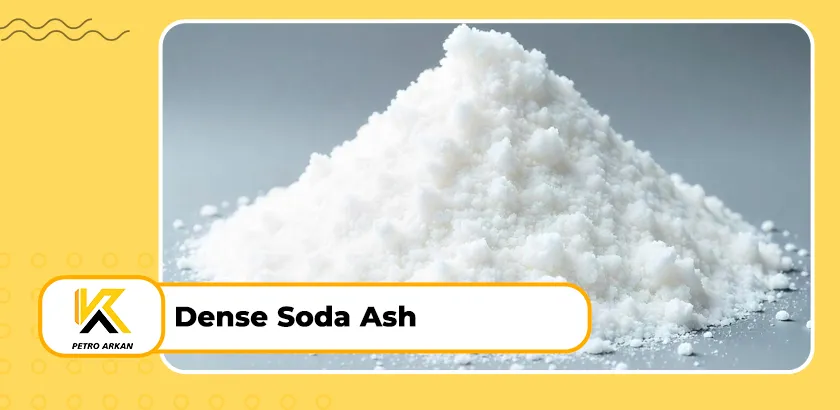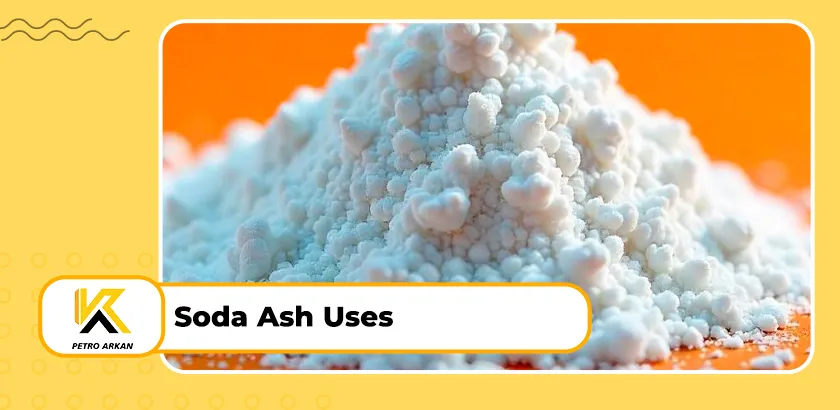SODA ASH
For over 5,000 years, soda ash has been at the heart of innovation, silently shaping the world we live in today. From the glass we gaze through to the batteries that power our devices, this unassuming powder has been an essential force behind some of the most groundbreaking industries.
At Petroarkan company, we harness the full potential of this ancient chemical to bring precision, sustainability, and excellence to industries worldwide.
Soda Ash Specification
Sodium carbonate, a product of over 5,000 years of history, is a major contributor to society today as one of the world’s most widely used inorganic substances.
It is a diverse ingredient that forms a key material in a tremendous range of sectors, from producing glass and powdered detergent to creating lithium-ion batteries. Sodium carbonate is also essential in the food and pharmaceutical industries.
This white, odorless powder is granular in texture with a mildly alkaline nature that has a pH level of around 11. It forms an alkaline solution when it is dissolved in water.
Because it is hygroscopic, Soda Ash can absorb moisture from the surrounding air, making it ready for use in a wide variety of different industrial applications. Innocuousness and simplicity have made Sodium carbonate a safe, reliable component of many various applications across the globe.

Types of Soda Ashs
Sodium carbonate comes in two main varieties, each with unique characteristics tailored to specific uses: dense sodium carbonate and light sodium carbonate. The primary differences between them lie in their density, particle size, and the types of applications they serve.
Dense Soda Ash
Soda ash dense has a greater density, approximately 1000 kilograms per cubic meter, and its granules are generally larger, ranging from 300 to 500 micrometers. This type is typically utilized in industries such as glassmaking, water treatment, and soap production.

Light Soda Ash
On the other hand, soda ash light has a lower density of roughly 500 kilograms per cubic meter, with finer particles that are about 100 micrometers in size. It contains 0.5% sodium chloride and is particularly valuable in the chemical industry, where it acts as a pH regulator.
Light sodium carbonate is also a key ingredient in the production of household chemicals and detergents.
Soda Ash Uses
Sodium carbonate finds importance in a vast array of industrial uses and daily tasks. From manufacturing techniques such as the production of glass and water treatment to useful domestic purposes, this unassuming substance delivers its worth in myriad forms.

Soda Ash in Gardening
Soil pH plays a crucial role in the health and growth of plants, influencing everything from nutrient absorption to root development. Below are the benefits of using sodium carbonate in gardening:
- Affects nutrient availability for plants
- Influences microbial activity in the soil
- Can inhibit plant growth when the soil is too acidic
- Enhances plant growth and vitality
- Promotes stronger root development
- Increases nutrient availability
- Helps prevent aluminum toxicity, which can limit root growth and nutrient absorption
Detergent Manufacture
Sodium carbonate is a classic ingredient in household cleaners, having replaced phosphates in the majority of detergents. It is used to boost the product cleaning power in products we utilize every day.
Glass Production
One of the essential ingredients in glassmaking, soda ash is included to reduce the melting point of silica, making possible the manufacture of glass. This remains one of its most prevalent uses.

Metallurgical Processes
In metallurgy, sodium carbonate serves a critical role in removing impurities such as sulfurs and phosphates from ferrous and non-ferrous ores. It also helps in recycling metals like zinc and aluminum.
Chemical Industry
Because of its high solubility, sodium carbonate has a lot of chemical reactions to be involved in. It’s one of the major raw materials for the production of fertilizers, dyes, and coloring agents. This substance is also used as a chemical factor in the petroleum and enameling sectors.
Soda Ash Pool
When the pH in a pool becomes too acidic, it can result in water that’s harsh enough to harm the pool’s liner, equipment, and even cause discomfort for swimmers, such as skin and eye irritation. Sodium carbonate helps by raising the pH levels, effectively neutralizing the acidic water and restoring balance to a more ideal range.

Air Pollution Control
Being an environmental guardian, sodium carbonate helps in the removal of harmful substances like sulfur dioxide and hydrochloric acid from industrial emissions, rendering the air purer.
Soda Ash Price
Understanding the key drivers behind sodium carbonate pricing can provide valuable insights into the broader economic forces at play. Below are some of the main factors that impact the cost of sodium carbonate:
- Market Demand and Supply: Supply and demand directly affect prices of sodium carbonate in the short run. Prices rise when demand is more than supply, and prices decrease when demand is less than supply, with price fluctuations usually remaining around the market or production price.
- Raw Material Costs: Price fluctuations in raw materials usually result in a change in product prices, with higher or increasing raw material costs usually leading to higher prices.
- National Economic Policies: National policy decisions can influence industries that are reliant on soda ash, such as glass manufacturing and printing, particularly in real estate industries. Since these industries are the backbone of the economy, any change in their direction may cause a swing in the price of sodium carbonate.
- Industry-Specific Problems: Expansion in the production capacity of the sodium carbonate industry itself, typically energized by continuing construction or plant renewals, can potentially lead to oversupply within the industry, thereby lowering prices for a while.
- Other Exogenous Variables: Transportation problems or natural disasters can also affect sodium carbonate pricing, disrupting supply channels and influencing the market in general.
Petroarkan, Transforming Industries with Chemistry that Drives Progress!
At Petroarkan, we don’t just create chemicals; we create solutions that power innovation and redefine industries. Our products are crafted with precision, sustainability, and a commitment to excellence -designed to not only meet today’s demands but to shape tomorrow’s possibilities.
Where to buy soda ash? Join us now to transform your world with the perfect sodium carbonate that drives real, lasting change.
Conclusion
As we stand on the shoulders of centuries of innovation, sodium carbonate continues to prove that sometimes the simplest elements create the most profound impacts. From shaping the glass we look through to revolutionizing industries and enriching lives, this humble powder remains a cornerstone of progress.
FAQ
- What are the types of sodium carbonate?
There are two main types: dense and light.
- What are the main uses of sodium carbonate?
Sodium carbonate is used in glass production, detergent manufacture, water treatment, air pollution control, and as a key ingredient in various chemical processes.
- Is sodium carbonate safe to use?
Yes, sodium carbonate is generally safe.
Showing all 2 results


